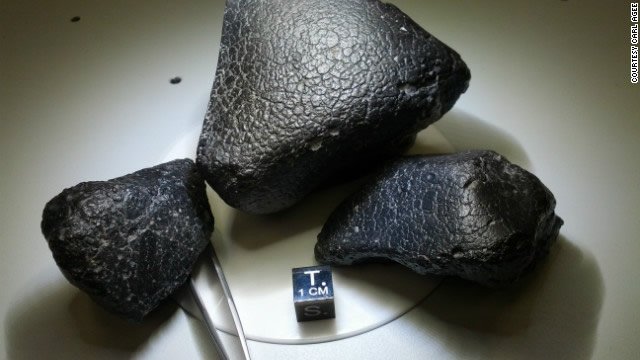
Ancient Meteorite Said to Harbor Secrets of Watery Martian Past
Black Beauty may tell the tale of the Red Planet’s youth.
News Source
Nomads dubbed the meteorite they found in the Sahara Desert in 2011 Black Beauty. Five pieces with a total weight of about 3.3 pounds, thought to have come from the same hunk of space debris, were eventually recovered and sold by dealers, finally ending up in the hands of scientists like Carl Agee and Munir Humayun, whose analyses have suggested new information about the Martian past. Black Beauty is unlike any meteorite previously discovered.
“It was shiny black on the outside, and when I cut into it, it was still very black, but it had also white specks and sparkling specks, and it looked really different than anything I’d ever seen,” said University of New Mexico’s Carl Agee, who examined part of the meteorite earlier this year. Scientists believe Black Beauty, unlike other Martian meteorites, was blasted from the Martian crust. They therefore hope it can tell them about the surface conditions of the Martian past.
Water From The Rock
Water can be trapped with the minerals comprising a rock, and when heated a meteorite containing trapped water can release the water vapor. Black Beauty’s pieces, when heated, yielded a great deal more water vapor than other Martian meteorites, anywhere from 10 to 30 times more. “That’s a lot of water to come out of a rock,” Agee says. “When that rock formed, it had to have been in an environment that was water rich. The water permeates in the rock, the minerals interact with it, and are locked away.”1

These are three of the five recovered pieces of “Black Beauty,” a meteorite thought to have come from the crust of the Martian southern hemisphere. They are conglomerates of basalt, feldspar, and pyroxene. They contain more trapped water than most meteorites. Water is thought to have been incorporated when the magma that produced the volcanic components was cooling. Image by Carl Agee, via CNN.2
Black Beauty’s Connection To Curiosity
Because Black Beauty contains the trace element iridium, thought to be associated with meteoric bombardment, scientists think it was blasted from Mars’ heavily cratered southern highlands. Black Beauty’s chemical composition seems to match that of the southern region being explored by the Martian rover Curiosity. If they are right, this will be the first opportunity to compare data from remote planetary analysis with information available from more extensive testing available on earth.
Scientists think that other meteorites presumed to be from Mars—about a hundred in all—came from bedrock in the flatter northern hemisphere. A meteorite from the Martian crust has a better chance of revealing clues about past conditions on the Martian surface.
No Signs Of Life
Scientists are hopeful that Black Beauty will reveal whether Mars ever harbored life. Black Beauty contained a significant amount of trapped water, which is essential for life. This suggests, along with the rest of the composition, scientists say, that Black Beauty was formed in a volcanic environment with a good deal of water, perhaps water released from the planet interior by volcanic processes along with carbon dioxide and nitrogen. Humayun suggests that such volcanic activity could have created “a very quick, thick atmosphere, perhaps even an ocean on the surface” and “very livable conditions” on Mars 4.4 billion years ago. “If there was a biosphere on Mars ever,” he says, “this is the time it would have originated.”
Evolutionary scientists assume that life could evolve through random processes anywhere there is water and habitable conditions. Therefore, while thus far there has been no evidence of Martian microbial life in Black Beauty, Humayun and Agee are hopeful they’ll find some.
A New Age

NWA 7533 is one of the pieces of the meteorite dubbed “Black Beauty.” Zircon crystals in it have been dated to 4.4 billion years, a date so soon after the supposed date of the solar system’s formation that scientists are surprised Mars could have developed a crust so soon. Image by Luc Labenne, via Popular Mechanics.3
Agee originally dated Black Beauty at 2.1 billion years. Florida State University’s Munir Humayun has just published a much older date for another of Black Beauty’s pieces, NWA 7533, at 4.4 billion years. Agee agrees with the new date, attributing the discrepancy to the composite nature of the material. This new date, based on the dating of several zircon crystals in the meteorite, is the oldest assigned to any Martian meteorite.4 “Since it takes time to build up a crust, and to allow that crust to process itself until it can start growing zircons,” Humayun says, “it's pretty amazing that we have such ancient zircon. A very large portion of the Martian crust must be very ancient.”
The evolutionary timescale embraced by the researchers puts the origin of the meteorite—4.4 billion years—within a “mere” 100 million years off the date now conventionally assigned to the origin of the solar system. “This date is about 100 million years after the first dust condensed in the solar system,” explains Humayun. “We now know that Mars had a crust within the first 100 million years of the start of planet building, and that Mars’ crust formed concurrently with the oldest crusts on Earth and the Moon.” 5
Black Beauty, Phone Home
Do scientists know for certain that Black Beauty’s home was Mars? Not really, but it is possible. Answers in Genesis geologist Dr. Andrew Snelling explains:
The basic argument starts with the assumption that meteorites slammed into Mars and produced its impact craters, but at the same time the impacts blasted out Martian rocks from the impact zones which escaped Mars’ gravity to hurtle earthwards.
The analyses of this meteorite show compositional similarities to soils and rocks tested in Gusev crater on Mars by NASA’s landed equipment. But there is no absolute proof that this meteorite came from Mars. All they have presented is circumstantial evidence. But it is a reasonable inference. And from our perspective it’s totally plausible from a young earth/young universe perspective to have debris coming to earth from Mars, blasted our way from an impact crater.
Coming Of Age
Black Beauty may hail from Mars, but the 4.4 billion year date assigned to the meteorite—as well as the 2.1 billion year date ascribed to some of its components—and hence to the Martian crust stretches credulity beyond the biblical historical record. The Bible is God’s Word, and the history contained in God’s own eyewitness account clearly indicates He created all that exists in the physical universe during the six literal (24-hour) days of Creation week. Thus, all the stars and galaxies, the solar system, the earth, all the kinds of plant and animal life and the first two humans, Adam and Eve came into being a mere 6,000 years ago.
The radiometric dating methods used to date the zircon components of this meteorite are being interpreted in accord with a number of unverifiable worldview-based assumptions which are at odds with God’s eye-witness testimony in the Bible. Dr. Snelling outlines this chain of assumptions:
They found zircon (zirconium silicate) and baddeleyite (zirconium oxide) grains in it and so applied the U-Pb radioisotope dating technique to obtain age data. They claim from their U-Pb concordia plot of the analyzed isotope ratios that the zircons are 4,428 ± 25 million years old, with the U-Pb system in the zircons being disturbed at 1,712 ± 85 million years ago by some later event.
They interpret the older date as representing the timing of formation of the Martian crust, which they claim is very similar to the timing of the same event on the earth and the moon, based on having obtained similar ages for zircons on the earth and the moon.
The whole basis for this interpretation is the observation that zircon is found in crustal rocks such as granites, whereas it isn’t found in rocks such as peridotites (rocks largely consisting of the mineral olivine) that appear to be derived from, and represent the composition of, the earth’s mantle.
By ignoring the biblical record, secular scientists ignore not only God’s eyewitness account of creation but also the historical account of the global Flood. The global Flood catastrophically remodeled the earth, so the Flood, in addition to the events of Creation week, make the uniformitarian assumptions inherent in much modern geological thinking unsound. Dr. Snelling says:
We would, of course, dispute the age interpretation of the U-Pb radioisotope analyses for three good reasons that directly overturn the assumptions being made about the reliability of the radioisotope dating method.
First, when God created the earth and Mars complete with their crust, mantle and core structures, there is no reason not to expect that He created all the isotopes of all the elements in the first Martian and earth crustal rocks. In other words, He not only created all the parent U isotopes, He also created the daughter Pb isotopes in the zircons in the first crustal rocks. So all the quantities of Pb isotopes these investigators measured today were not derived from radioactive decay of U, contrary to the assumption made by these investigators.
Second, there is good evidence in earth rocks that the rate of radioactive decay has not been constant through time, having been accelerated along with other geologic and physical processes to catastrophic rates during the global Flood cataclysm (which the evidence of impact cratering suggests affected the entire solar system). So the U-Pb radioisotope “clock” has not always “ticked” at the same rate.
And third, there is no guarantee that the U-Pb system hasn’t been disturbed and/or contaminated through all those supposed millions of years, and during the blasting off the Martian surface, the hurtling through space, the fiery entry through the earth’s atmosphere, and the time lying on the African desert surface. After all, the investigators themselves recognized the U-Pb system had been disturbed by a later event. So all three assumptions on which this 4,428± 25 million years old “age” claim is made are demonstrably faulty, meaning that it is not the real-time age of these zircons, and therefore of the meteorite, telling us nothing about the age of Mars.
Radiometric dating methods must be calibrated, and if they are calibrated in accordance with faulty assumptions—which they are—then the dates they provide are untrustworthy.
The Solar System
The nebular hypothesis also violates the law of conservation of angular momentum.
The “nebular hypothesis” is currently believed by most secular scientists to explain the origin of the solar system, including of course Mars. They maintain that our solar system formed about 4.6 billion years ago from a cloud of dust and gas. However, the nebular hypothesis demands that fast-moving particles accreted together to form planetesimals rather than bouncing off each other or exploding on impact. The nebular hypothesis also violates the law of conservation of angular momentum. Despite these problems, most secular scientists cling to the hypothetical nebula from which they know we sprang despite the aberrant physics it demands.
Scripture does provide the actual history of our solar system. Dr. Snelling explains:
No human has observed any of these claimed processes, even the claimed formation of the crusts of the earth and Mars. The only reliable eyewitness we know who was there and saw the formation of the earth and Mars is God the Creator, who is utterly holy and truthful. He tells us in His Spirit-breathed Word that He created the earth first out of nothing and formed its basic structure covered in water, and that four normal days later He made all the heavenly bodies including Mars. The earth and Mars were not made from the fiery coalescing of material flung out of a proto-Sun, but were created by Him fully formed complete with rocky interiors and surfaces. Neither the earth nor Mars formed by naturalistic processes, contrary to the overarching assumption of these investigators and the modern scientific enterprise they represent.
So while the investigated meteorite probably did get blasted to the earth by an impact on Mars, it is certainly not over 4 billion years old. Based on the absolute authority of God’s infallible and inerrant Word, the earth and Mars were created direct by God’s hands during the Creation Week only about 6,000 years ago, and not by some random naturalistic processes billions of years ago. And the impact event on Mars that likely blasted this meteorite fragment to the earth occurred after the Flood cataclysm on earth (because the meteorite landed on today’s African desert surface), a residual effect in the aftermath of the Flood.
Looking For Life
As to the question of water and life, it is only the evolutionary assumption that life evolved from non-living elements through random processes—a notion without any observable evidence—that prompts some scientists to assume that where there is water, life could have evolved.
The possibility that Mars once had a different environment allowing the presence of liquid water does nothing to support the idea that our solar system formed billions of years ago. The belief that life evolved on earth is also based on unverifiable assumptions. If evidence of microbial life—past or present—on Mars is eventually found, evolutionists will of course claim that life proves evolution happened. But in reality, such a finding would simply be evidence that life is (or once was) there, not a demonstration of that life’s origins by naturalistic evolutionary processes. The Bible does not say whether God created life on any other planets, but the Bible does tell us God created all life on earth during the six days of Creation Week, the same week in which He created the rest of the universe, about 6,000 years ago. Discovery of evidence of water and even life on Mars would not disprove or undermine that biblical truth.
Further Reading
- Meteorite Water Evidence Suggests Mars’ Wet Past
- Looking for Water in all the Right Places
- The Curious Case of Martian Mania
- Extrasolar Planets Suggest our Solar System is Unique and Young
- Sun and Planets Built Differently Says Nasa
- The Martian Runt
- Does the Secret of the Earth’s Origin Abide in the Planet’s Core?
- Sutter’s Mill Meteorite Harbors a Wealth of Elusive Organics
- Did Life’s Molecular Building Blocks Come from Mars?
For More Information: Get Answers
Remember, if you see a news story that might merit some attention, let us know about it! (Note: if the story originates from the Associated Press, FOX News, MSNBC, the New York Times, or another major national media outlet, we will most likely have already heard about it.) And thanks to all of our readers who have submitted great news tips to us. If you didn’t catch all the latest News to Know, why not take a look to see what you’ve missed?
(Please note that links will take you directly to the source. Answers in Genesis is not responsible for content on the websites to which we refer. For more information, please see our Privacy Policy.)
Footnotes
- Darren Orf, “The Ancient Martian Rock that Fell to Earth,” Popular Mechanics, November 20, 2013, http://www.popularmechanics.com/science/space/moon-mars/the-ancient-martian-rock-that-fell-to-earth-16179984.
- Elizabeth Landau, “Meteorite Unveils Secrets of Ancient Mars,” CNN, November 20, 2013, http://www.cnn.com/2013/11/20/tech/innovation/mars-meteorite/.
- Orf, “The Ancient Martian Rock that Fell to Earth.”
- . . . with the possible exception of the Allan Hills meteorite found in Antarctica in 1996, about which there has been some controversy.
- Kathleen Laufenberg, “Researcher Uncovers Secrets of Mars’ Birth from Unique Meteorite,” Florida State University, November 21, 2013, http://www.fsu.edu/indexTOFStory.html?lead.mars.
Recommended Resources

Answers in Genesis is an apologetics ministry, dedicated to helping Christians defend their faith and proclaim the good news of Jesus Christ.
- Customer Service 800.778.3390
- © 2024 Answers in Genesis







